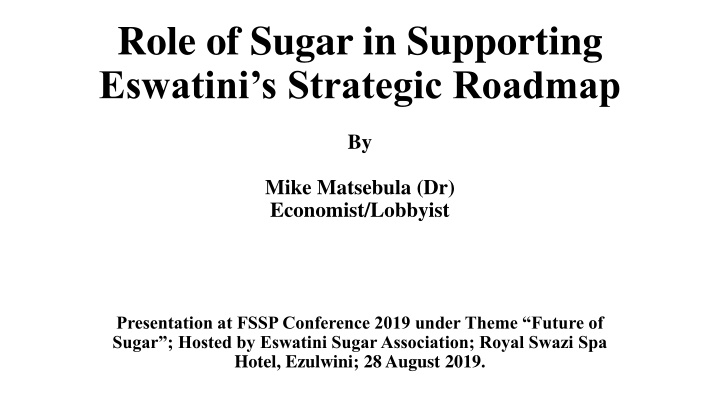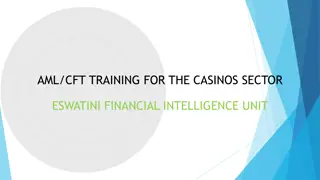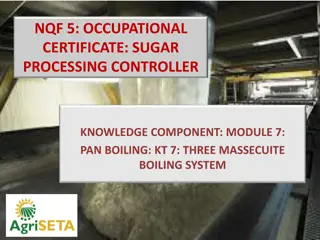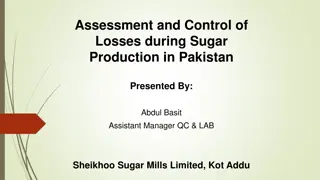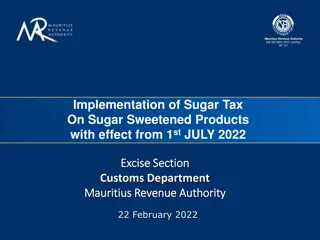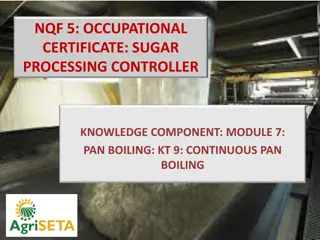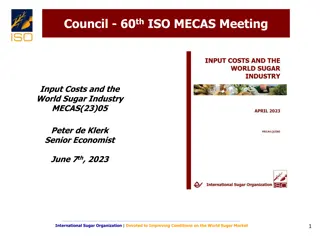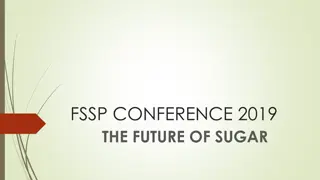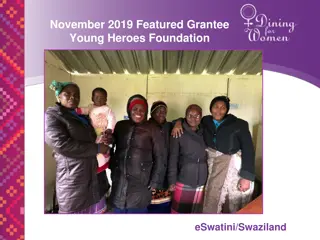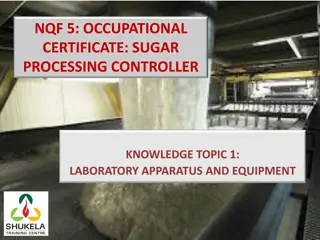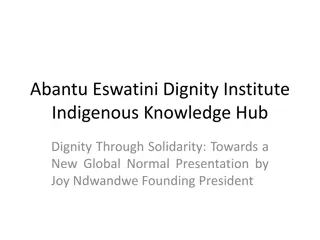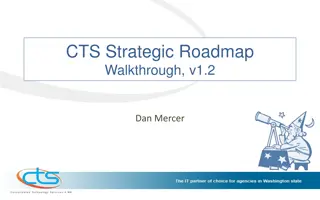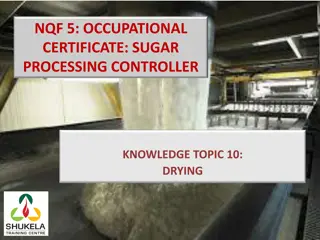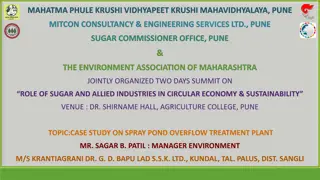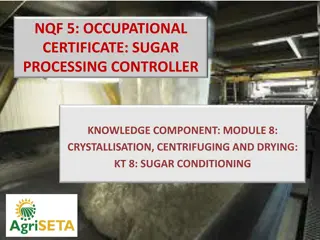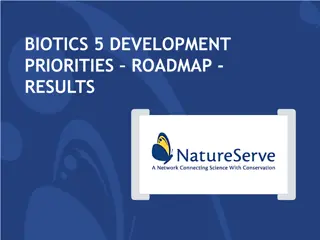Role of Sugar Industry in Eswatini's Strategic Roadmap
The sugar industry in Eswatini plays a significant role in the economy, contributing to various sectors and social services. Through its multi-functional nature, it supports the Eswatini Strategic Roadmap by directly impacting key growth sectors like agriculture and agro-processing. The industry's positive effects extend to job creation, GDP growth, and public revenue mobilization, making it a vital player in the country's development agenda.
Download Presentation

Please find below an Image/Link to download the presentation.
The content on the website is provided AS IS for your information and personal use only. It may not be sold, licensed, or shared on other websites without obtaining consent from the author.If you encounter any issues during the download, it is possible that the publisher has removed the file from their server.
You are allowed to download the files provided on this website for personal or commercial use, subject to the condition that they are used lawfully. All files are the property of their respective owners.
The content on the website is provided AS IS for your information and personal use only. It may not be sold, licensed, or shared on other websites without obtaining consent from the author.
E N D
Presentation Transcript
Role of Sugar in Supporting Eswatini s Strategic Roadmap By Mike Matsebula (Dr) Economist/Lobbyist Presentation at FSSP Conference 2019 under Theme Future of Sugar ; Hosted by Eswatini Sugar Association; Royal Swazi Spa Hotel, Ezulwini; 28 August 2019.
OUTLINE Nature and importance of sugar industry (SI) in Eswatini: It will be found that the SI plays a multi-functional role. This will set the stage for determining the possible role it can play in supporting the Eswatini Strategic Roadmap (ESR). Role of SI in supporting the ESR: Based on its multi-functional characteristic. Harnessing the potential of the SI to make an impact on ESR implementation: Examples intended to elicit serious thinking. Financing the SI efforts towards supporting the ESR implementation. Conclusion.
NATURE & IMPORTANCE OF SI IN ESWATINI It has a high profile relative to the overall economy as revealed by its substantial contributions to agricultural employment and output; manufacturing employment and output; national export earnings; public revenues through company, personal income and value added taxes. It contributes significantly to social services in the form of education, health care, housing, water, sanitation and recreational facilities. It is directly linked to various sectors in the overall economy through both the input and output sides. Adding indirect linkages pushes up the multiplier and accelerator effects; thus raising the potential of the SI to be impactful.
NATURE & IMPORTANCE OF SI (Contd) Examples of links through the input side are transportation, fertilizer, chemicals, labour and financial services. Examples of links through the output side are prepacking, beverages, sweets, various sugar-containing products and export sector. It conducts its activities in an environmentally friendly manner. It has also set aside a significant amount of land for the preservation of natural flora and fauna. It has contributed positively to deeper economic integration within SACU. In particular, it sells more than one-half of its total tonnage into SACU and sources virtually all of its non- labour inputs from South Africa.
ROLE OF SI IN SUPPORTING ESR To define this role, where exactly in the ESR does the SI directly fit? The ESR identifies five key growth sectors on the basis of their ability to deliver high impact on GDP growth, job creation and public revenue mobilization. The SI fits in two of these sectors namely, agriculture (because of sugarcane growing) and agro-processing/manufacturing (because of the processing of sugarcane to produce sugar). It is directly through these two dimensions that the SI can play a positive role in the ESR implementation. These two sectors are the direct conduits for defining the role of the SI. Indirect conduits exist through the other key growth sectors because of linkages involving the SI.
ROLE OF SI IN SUPPORTING ESR (Contd) When fulfilling its role in the ESR, the SI will also be contributing to Eswatini s obligations to be achieved under Africa s Agenda 2063 and UN s Agenda 2030. Agenda 2063 was adopted in January 2015. Through it, Africa is striving for accelerated and inclusive growth with equity; growth which will result in job creation, poverty eradication and sustainable socioeconomic development. It specifies targets. Agenda 2030 is a post-2015 universal development agenda adopted in September 2015. It recognizes that eradicating poverty in all its forms and dimensions is the greatest global challenge and an indispensable requirement for sustainable development. The plan of action specifies 17 SDGs.
HARNESSING POTENTIAL OF THE SI The potential of the SI to make an impact on the ESR implementation is defined by its multi-functional nature. I cannot prescribe to the SI how it should harness this potential. What I can do is make points intended to stimulate some deep thinking on how the potential of the SI can be harnessed and brought to bear on the successful implementation of the ESR. The starting point is to recognize the existence of important stakeholders both inside and outside the SI. A programme towards harnessing the potential already alluded to must be compiled and discussed with all the key stakeholders. The guiding principle in this process must be the attainment of sustainable growth for the benefit of current and future generations.
HARNESSING POTENTIAL OF THE SI (Contd) In this connection, it is important to note that UNESCO has designated the Lubombo Region as a Biosphere Reserve. Given that the SI lies mostly in the Lubombo Region, there are synergies which can be generated. Indeed, through its operations and nature reserves, the SI is already a major player in this Region from a sustainability perspective. The compilation of a programme for the SI to contribute positively to the ESR implementation should be done under an appropriate theme. It could be along the lines SI Efforts Towards a Sustainable Contribution to the ESR . We turn to some of the main elements for consideration in this harnessing endeavor.
1. DIVERSIFICATION OF SI PRODUCTS Examples would include ethanol for fuel blending; alcoholic beverages; electricity cogeneration to supply the national grid; bio-degradable plastics; and animal feeds. The need for product diversification is definitely not a new issue for the Eswatini SI. Examples elsewhere in SADC abound. The question is why has it not taken off in a visible manner for the benefit of all SI members in Eswatini? Are the financial and social returns foregone by not embarking on this journey insignificant? Should there be special incentives considered and, if so, what kind? In theory, the incentives can range from moral suasion through policy prescription to legislation. Some discussion is necessary to clear the air.
2. DIVERSIFICATION OF SUGAR MARKETS This is an issue which is already being pursued collectively by SADC SIs. With the launch of the African Continental Free Trade Area, a new dimension has been added to the pursuit of remunerative markets by SADC SIs. The collective SADC approach is worth retaining in discussions with other regions in Africa. It is of utmost importance that each SADC SI keeps its government fully in the picture as negotiations ensue and to seek specific support where such is necessary to gain access into various African sugar markets. This assertion is based on the multi-functional role of the SI which makes it strategic from a socio-economic perspective. It requires a strong political will and different types of interventions for nurturing it.
3. ECONOMIC EMPOWERMENT OF EMASWATI The support given by government (through bulk water projects) and by the EU (through part-financing of development costs) has empowered a considerable number of smallholder sugarcane growers. This was a good move from a social return perspective. The non-sugar small and medium enterprise (SME) sector in the Lubombo Region needs to be systematically empowered. One option is to empower SMEs through a mentorship arrangement negotiated among the Eswatini Sugar Association, relevant members of the SI, potential SMEs and financiers. The objective of the mentorship programme would be to reduce the risk of SME failure and thereby enhance chances of creating sustainable financial as well as social returns in the sugarbelt.
ECONOMIC EMPOWERMENT (Contd) A second option is providing infrastructure to promote SI tourism through which the beauty of cane fields can be appreciated by local and foreign visitors. The infrastructure would comprise facilities which are strategically located around the sugarbelt to service tourists through refreshments, indigenous foods, handicrafts and restrooms. SMEs should pay affordable rentals to operate in these facilities. The Sugar Museum at Tambankulu would be part of this SI tourism concept. Improvements in facilities used by informal sector operators (commonly referred to as community markets) is a third option.
FINANCING SI EFFORTS To evaluate, plan and put in motion the SI support towards ESR implementation requires money and skills. A consultancy is required to do all the groundwork pertaining to the required resources. The consultancy should ideally report to a team convened by the Eswatini Sugar Association to compile a programme towards the sourcing of the necessary funding. Possible funding sources would include the local banking sector and impact investors. The latter are funds whose intention is to generate a measurable beneficial social impact alongside a financial return. Impact investors provide capital on affordable terms to address social issues such as poverty, social inequalities and environmental degradation. Tapping these funds may take a long time.
CONCLUSION With a bit of thinking out of the box, a good dose of planning and lots of hard work, the SI industry can be made to contribute significantly to the successful implementation of the ESR. Siyabonga!
